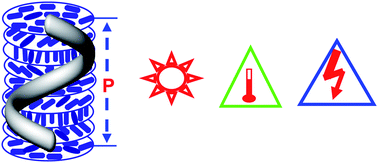Thermally, photochemically and electrically switchable reflection colors from self-organized chiral bent-core liquid crystals
Abstract
We report the synthesis and characterization of two new chiral

* Corresponding authors
a
Liquid Crystal Institute, Kent State University, Kent, Ohio, USA
E-mail:
qli1@kent.edu
Fax: +1-330-672-2796
Tel: +1-330-672-1537
We report the synthesis and characterization of two new chiral

 Please wait while we load your content...
Something went wrong. Try again?
Please wait while we load your content...
Something went wrong. Try again?
M. Mathews, R. S. Zola, D. Yang and Q. Li, J. Mater. Chem., 2011, 21, 2098 DOI: 10.1039/C0JM03479G
To request permission to reproduce material from this article, please go to the Copyright Clearance Center request page.
If you are an author contributing to an RSC publication, you do not need to request permission provided correct acknowledgement is given.
If you are the author of this article, you do not need to request permission to reproduce figures and diagrams provided correct acknowledgement is given. If you want to reproduce the whole article in a third-party publication (excluding your thesis/dissertation for which permission is not required) please go to the Copyright Clearance Center request page.
Read more about how to correctly acknowledge RSC content.
 Fetching data from CrossRef.
Fetching data from CrossRef.
This may take some time to load.
Loading related content
